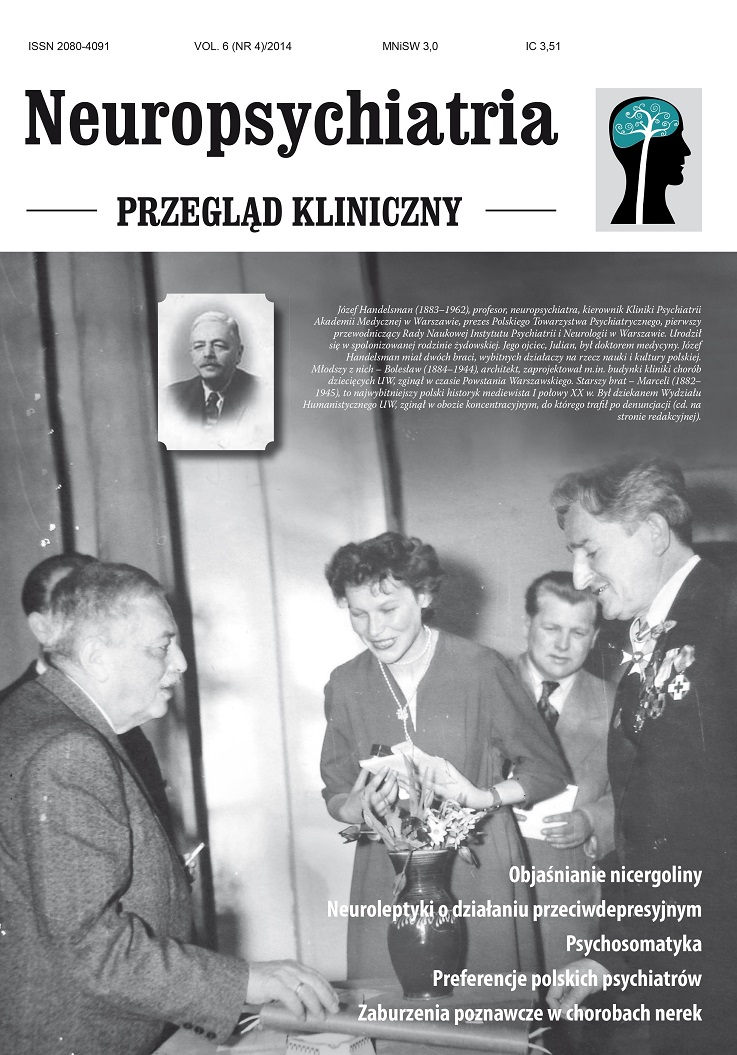Zaburzenia występujące pod postacią somatyczną – problem diagnostyczny i terapeutyczny Artykuł przeglądowy
##plugins.themes.bootstrap3.article.main##
Abstrakt
Zaburzenia somatyzacyjne to niejednorodna grupa zaburzeń, z którymi w codziennej praktyce mogą się spotkać lekarze wszystkich specjalności. Najczęściej jednak problem ten dotyka pacjentów podstawowej opieki zdrowotnej oraz psychiatrii. Z uwagi na symptomatologię i niespecyficzne objawy rozpoznanie tych zaburzeń jest zwykle opóźnione w czasie. Dla niektórych pacjentów zaburzenia te są źródłem istotnego pogorszenia funkcjonowania. W leczeniu uwzględnia się zarówno oddziaływania psychoterapeutyczne, jak i farmakoterapię.
##plugins.themes.bootstrap3.article.details##

Utwór dostępny jest na licencji Creative Commons Uznanie autorstwa – Użycie niekomercyjne – Bez utworów zależnych 4.0 Międzynarodowe.
Copyright: © Medical Education sp. z o.o. License allowing third parties to copy and redistribute the material in any medium or format and to remix, transform, and build upon the material, provided the original work is properly cited and states its license.
Address reprint requests to: Medical Education, Marcin Kuźma (marcin.kuzma@mededu.pl)
Bibliografia
2. Ey H. Manuel de Psychiatrie. Masson, Paris 1965.
3. Lipowski ZJ. Somatization: the concept and its clinical applications. Am J Psychiatry 1988; 145: 1358.
4. Kryteria diagnostyczne według DSM-IV-TR. Jacek Wciórka (red. wyd. pol.). Wyd. Elsevier 2008.
5. Diagnostic and Statistical Manual of Mental Disorders. 5th ed. American Psychiatric Association.
6. Ustun TB, Sartorius N (red.). Mental illness in General Health Care: An Interantional Study. Wiley, Chichester, UK, 1995.
7. Henningsen P, Zipfel S, Herzog W. Management of functional somatic syndromes. Lancet 2007; 369-946.
8. Kaplan & Sacock’s Comprehensive Textbook of Psychiatry. 9th ed. Lippincott Williams & Wilkins 2009.
9. Escobar J. Transcultural aspects of dissociative and somatoform disorders. Psychiatr Clin North Am 1995; 18(3): 555.
10. Escobar JI, Burnam MA, Karno M. Somatization in the community. Arch Gen Psychiatry 1987; 44: 713.
11. American Psychiatric Association. Diagnostic and Statistical Manual of Mental Disorders, 4th ed, text Revision. Washington, DC. American Psychiatric Association 2005.
12. Barsky AJ, Orav EJ, Bates DW. Somatization increases medical utilization and costs independent od psychiatric and medial comorbidity. Arch Gen Psychiatry 2005; 62: 903-910.
13. Rife W, Buhl Mann U, Wilhelm S et al. The prevalence of body dysmorphic disorder: a population-based survey. Psychol Med 2006; 46: 317-325.
14. Feusner JD, Yaryura-Tobias J, Saxena S. The pathophysiology of body dysmorphic disorder. Body Image 2008; 5(1): 3-12.
15. Fallon BA, Qureshi AI, Laje G et al. Hypochondriasis and its relationship to obsessive – compulsive disorder. Psychiatr Clin North Am 2000; 23(3): 605-16. Review.
16. Freyberger HJ, Grabe HJ, Maier W et al. Opipramol (Insidon) in the treatment of somatoform disorders. Fortschr Neurol Psychiatr 1998; 66(Suppl 1): S25-30.
17. Grabe HJ, Freyberger HJ, Maier W et al. In der Anwendung Opipramol bei somatoformen Storungen. Nervenheilkunde 1999; 17: 571-576.
18. Mohapatra S, Rath NM, Agrawal A et al. Opipramol: Novel Drug. Delhi Psychiatry Journal 2013; 16(2).
19. Fallon B, Petkova E, Skritskaya N et al. A Double-masked placebo- controlled study of fluoxetine for hypochondriasis. J Clin Psychopharmacol 2008; 28: 638.
20. Kroenke K. Efficacy of treatment for somatoform disorders: a review of randomized cotrolled trials. Psychosom Med 2007; 69: 881-888.
21. O’Malley PG, Jackson JL, Santoro J et al. Antidepressant therapy for unexplained symptoms and symptom syndromes. J Fam Pract 1999; 48: 980-990.
22. Max MB, Lynch SA, Muir J et al. Effects of desipramine, amitriptyline, and fluoxetine on pain in diabetic neuropathy. N Engl J Med 1992; 326: 1250-1256.
23. Max MB. Treatment of post-herpetic neuralgia: antidepressants. Ann Neurol 1994; 35(Suppl L): 50-53.
24. Briley M. Clinical experience with dual action antidepressants in different chronic pain syndromes. Hum Psychopharmacol 2004; 19(Suppl 1): 21-25.
25. Barsky AJ, Ahern DK. Cognitive behavior therapy for hypochondriasis. JAMA 2004; 291: 1464-1470.
26. Thomson AB, Page LA. Psychotherapies for hypochondriasis. Cochrane Database System Rev. 2008; 1.

